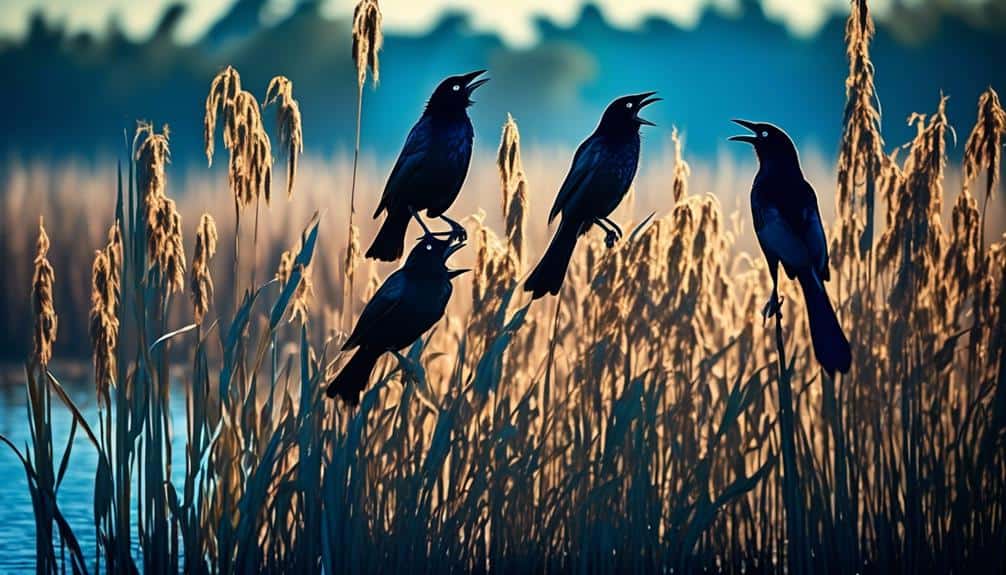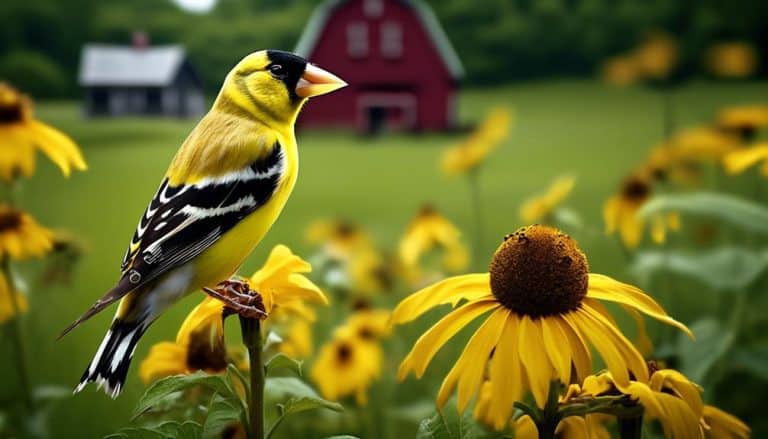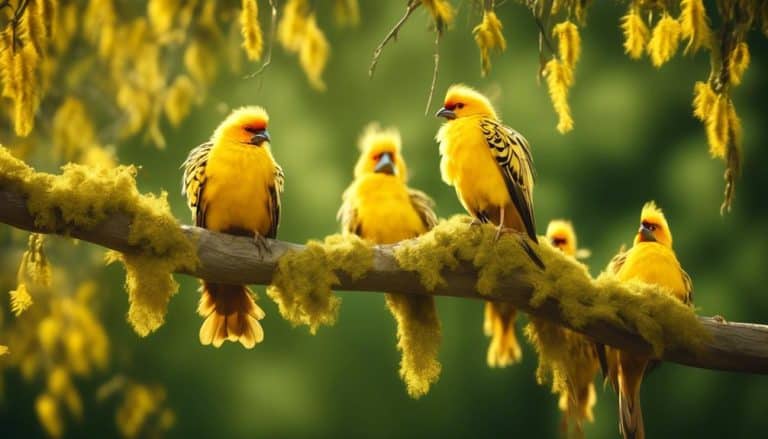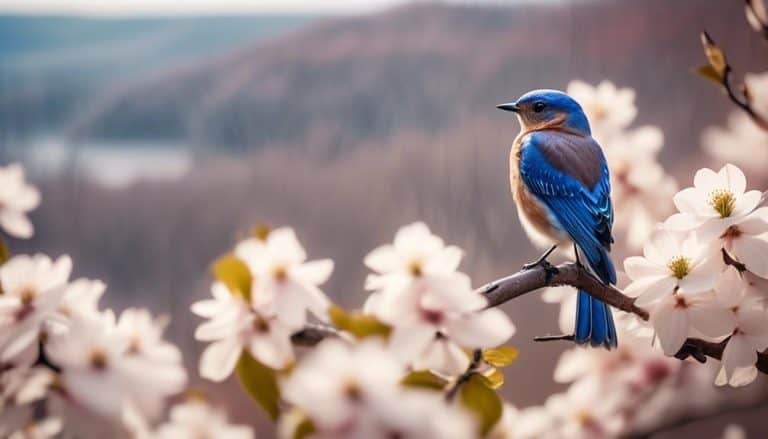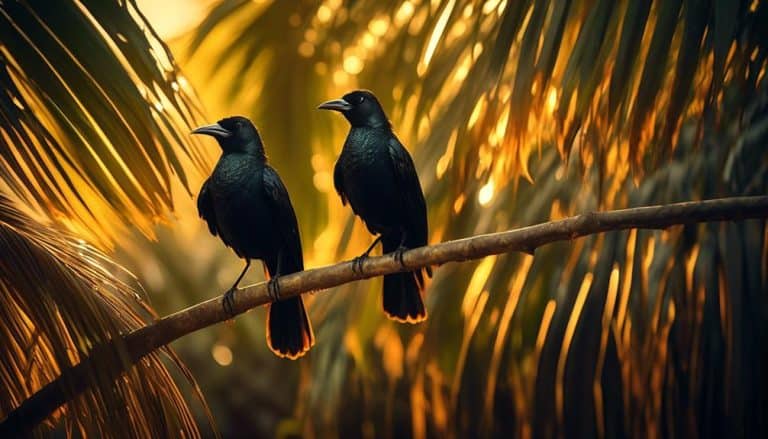As I sat on my porch, sipping my morning coffee, I couldn't help but notice the grackle black birds that filled the sky, their wings beating in perfect harmony.
These mysterious creatures have always intrigued me, and I've often wondered about their behavior, habitat, and the role they play in the intricate web of Florida's wildlife.
Join me as we explore the fascinating world of grackle black birds and uncover the secrets that lie within their iridescent feathers.
Behavior of Grackle Black Birds
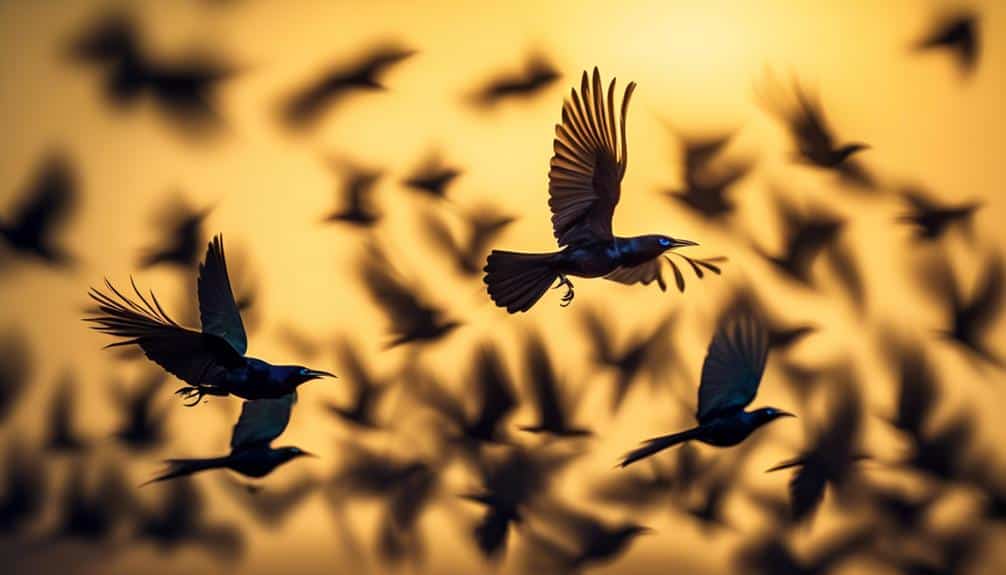
I have observed that Grackle Black Birds in Florida exhibit complex and fascinating behavioral patterns. One of the most intriguing aspects of their behavior is their communication patterns.
Grackles are highly vocal birds, and their calls serve various purposes within the flock dynamics.
When observing a flock of Grackle Black Birds, it becomes evident that they use different calls to communicate different messages. The most common call is a distinct, high-pitched whistle, which is often used by individuals to maintain contact with the rest of the group. This call seems to serve as a form of cohesion, keeping the flock together as they forage or fly.
However, Grackles also have a repertoire of other calls that convey different meanings. For example, they emit a harsh, loud call when they sense danger or perceive a threat. This alarm call acts as a warning to other members of the flock, enabling them to take evasive action or seek cover.
Interestingly, Grackle Black Birds also engage in what appears to be coordinated vocal displays. During these displays, multiple individuals within the flock produce a series of calls in a synchronized manner. This behavior might serve to strengthen social bonds and reinforce the group's cohesion.
Habitat of Grackle Black Birds
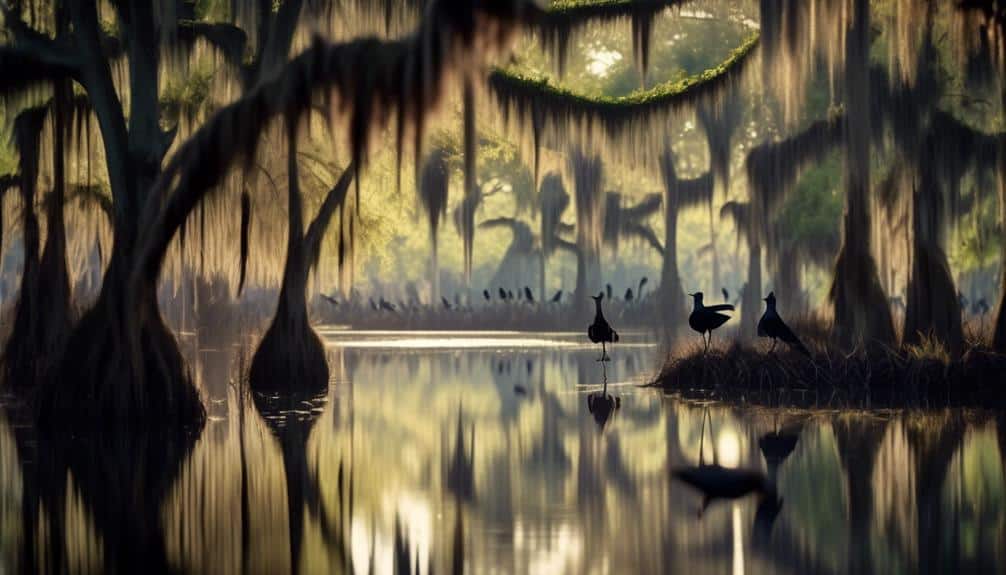
The habitat of Grackle Black Birds in Florida is diverse and encompasses a range of environments including urban areas, agricultural fields, wetlands, and wooded areas. These adaptable birds have managed to thrive in various landscapes, making them a common sight throughout the state. Observing their behavior across these different habitats has provided valuable insights into their population dynamics and the threats they face.
- Urban areas: Grackle Black Birds are often found in urban environments, where they take advantage of human structures for nesting and food sources. Their adaptability allows them to navigate busy city streets and interact with humans.
- Agricultural fields: Grackles are known to forage in agricultural fields, where they feed on grains and insects. These fields provide abundant food resources for the birds, contributing to their population growth.
- Wetlands: Wetlands are crucial habitats for Grackle Black Birds, as they provide nesting sites and a diverse range of food sources, including aquatic invertebrates and amphibians.
- Wooded areas: Grackles are also found in wooded areas, where they nest and roost in trees. These habitats offer protection from predators and provide opportunities for foraging on fruits, seeds, and insects.
As the Grackle population continues to grow, their habitats face increasing threats. Urban development encroaches on their nesting sites, while the use of pesticides in agricultural fields reduces their food availability. Wetland degradation and deforestation also pose significant challenges to their survival.
It's important to address these threats and implement conservation measures to ensure the long-term viability of Grackle Black Bird populations in Florida.
Diet of Grackle Black Birds
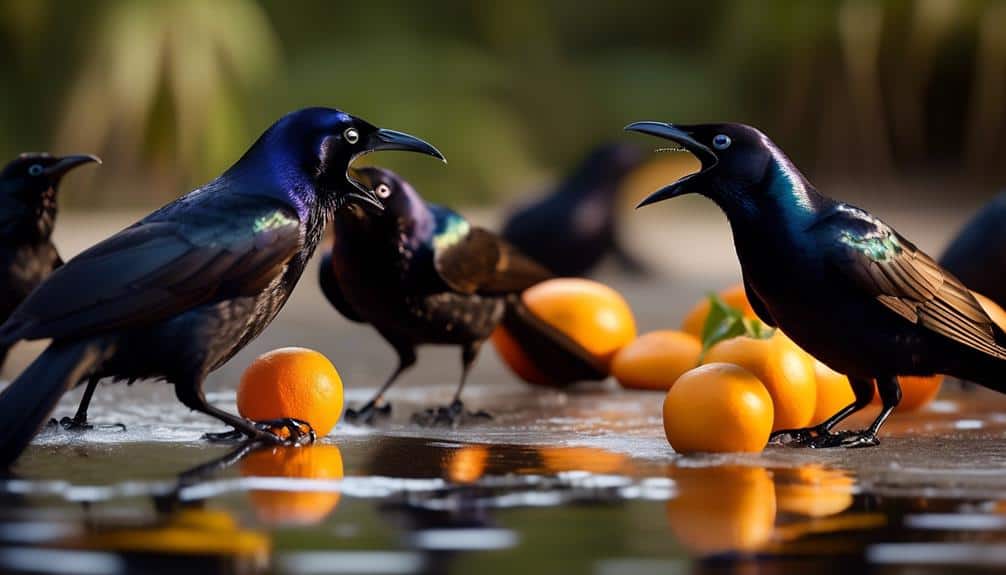
Grackle Black Birds demonstrate a diverse and adaptable diet, consisting of a variety of food sources found in their habitats throughout Florida. These birds have a unique foraging style that allows them to explore a wide range of food options. They're known to feed on both plant matter and small animals, making them omnivorous in nature.
When it comes to plant matter, Grackle Black Birds are particularly fond of seeds, grains, fruits, and berries. They're often seen foraging in agricultural fields, where they can have a significant impact on crops. Their voracious appetite for grains, such as corn and rice, can result in substantial losses for farmers.
In addition to plant-based foods, Grackle Black Birds also consume insects, spiders, and small vertebrates. They're skilled hunters, using their sharp beaks to catch prey. This diverse diet allows them to thrive in various habitats, as they aren't solely dependent on one food source.
It is important to note that while Grackle Black Birds are beneficial in controlling insect populations, their impact on agricultural crops can be detrimental. Farmers often employ various strategies, such as scare tactics or netting, to minimize the damage caused by these birds.
Reproduction and Nesting Habits
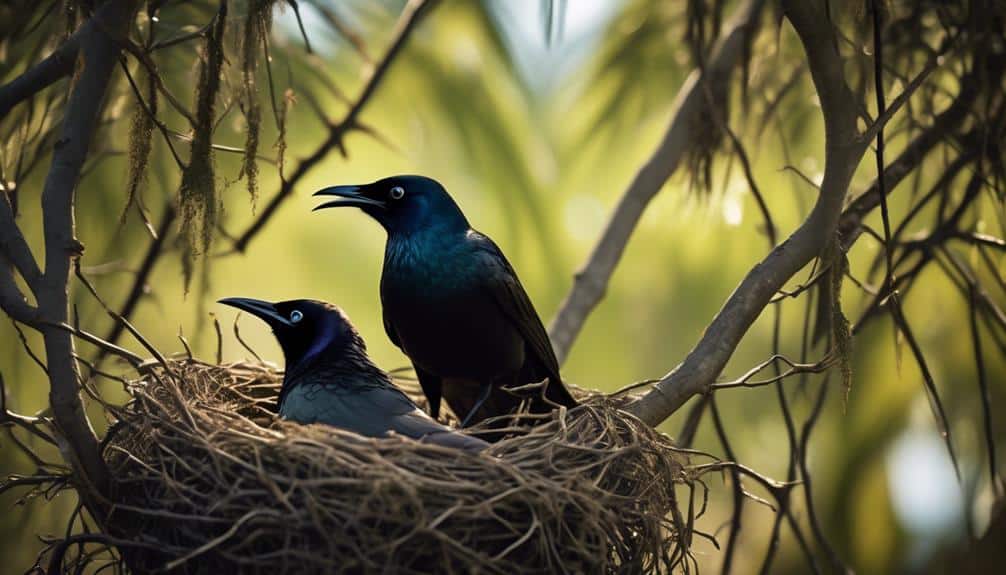
During the breeding season, female Grackle Black Birds construct intricate nests using a combination of twigs, grasses, and other materials found in their surroundings. These nests serve as a safe haven for their eggs and provide a secure environment for the hatchlings.
Here is a closer look at the reproduction and nesting habits of Grackle Black Birds in Florida:
- The female Grackle Black Bird typically selects a sturdy tree branch or shrub to build her nest. She carefully weaves the twigs together, creating a sturdy foundation.
- To add insulation and protection from the elements, the female lines the nest with soft grasses and feathers. This helps to keep the eggs warm and shielded from any potential predators.
- The female Grackle Black Bird lays a clutch of 3-5 eggs, which she incubates for about two weeks. During this time, the male Grackle Black Bird diligently guards the nest, ensuring the safety of the precious eggs.
- Once the eggs hatch, both parents take turns feeding and caring for the nestlings. They tirelessly search for insects, seeds, and berries to provide their growing chicks with a nutritious diet.
- After about three weeks, the young Grackle Black Birds fledge from the nest and begin their own journey in the world. The parents continue to care for them for a few more weeks until they become independent and self-sufficient.
The breeding season and nesting habits of Grackle Black Birds in Florida are a testament to their dedication and perseverance in ensuring the survival of their species.
Interaction With Other Wildlife
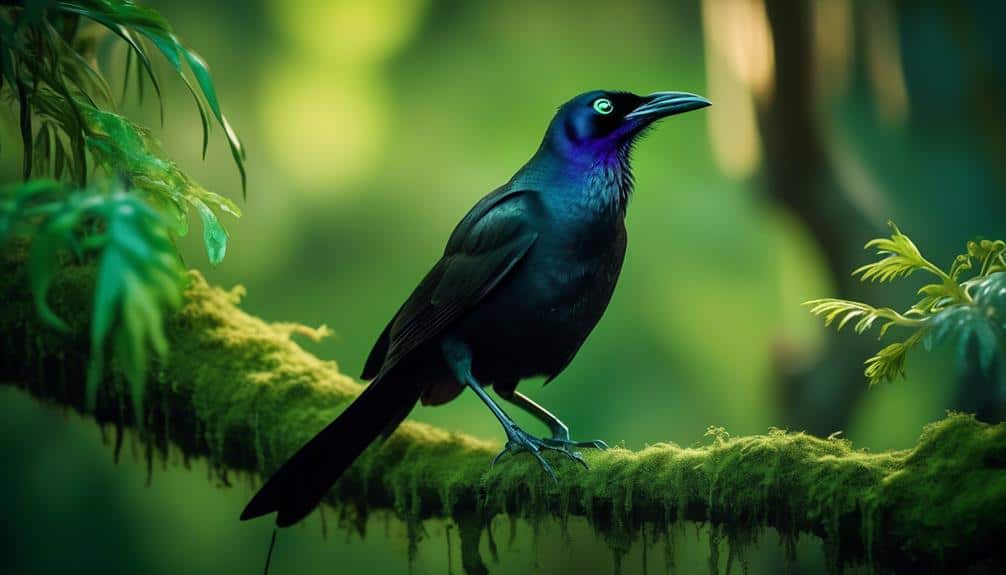
As the female Grackle Black Bird diligently constructs her intricate nest, she unknowingly sets the stage for fascinating interactions with other wildlife in Florida.
These interactions include both predation risks faced by Grackle Black Birds and their interactions with native bird species in Florida.
Predation is a constant threat to Grackle Black Birds and their nests. They're targeted by predators such as raccoons, snakes, and other birds of prey. The female Grackle Black Bird must be vigilant, constantly on the lookout for potential threats. She uses her keen senses to detect any signs of danger and quickly alerts her mate or other nearby grackles.
In addition to predation risks, Grackle Black Birds also interact with a variety of native bird species in Florida. They often share foraging areas and compete for food resources, such as insects and berries. However, these interactions can also be cooperative, as Grackle Black Birds may join mixed-species flocks, where different bird species work together to find food and provide mutual protection.
Conservation and Management Efforts

Conservation and management efforts have been implemented to protect and preserve the habitat of the Grackle Black Birds in Florida. These initiatives are crucial in ensuring the survival of this unique species. The grackle black bird population has faced numerous threats in recent years, making conservation efforts all the more important.
To address these challenges, several measures have been put in place:
- Habitat Restoration: Efforts are being made to restore and enhance the natural habitats of grackle black birds. This involves reestablishing native vegetation and creating diverse ecosystems that support their population.
- Predator Control: Strategies are being implemented to manage predators that pose a threat to grackle black birds. This includes monitoring and removing invasive species that may prey on their eggs or young.
- Public Awareness Campaigns: Raising awareness about the importance of grackle black bird conservation is crucial. Educational programs and outreach initiatives aim to inform the public about the threats they face and the actions needed to protect them.
- Research and Monitoring: Ongoing research and monitoring programs help gather valuable data on grackle black bird populations. This information is used to assess population trends, identify potential threats, and guide conservation efforts.
- Collaboration and Partnerships: Conservation organizations, government agencies, and local communities are working together to develop comprehensive conservation plans. Collaborative efforts ensure a coordinated approach to protect and manage grackle black bird habitats effectively.
Frequently Asked Questions
Can Grackle Black Birds Cause Damage to Crops or Gardens?
Yes, grackle black birds can cause damage to crops and gardens. They feed on fruits, vegetables, and seeds, leading to reduced yields. To deter them, methods like using scare devices or netting can be effective.
Are Grackle Black Birds Migratory or Do They Reside in Florida Year-Round?
Grackle black birds, fascinating creatures, their migratory patterns intrigue me. Do they call Florida home year-round or just visit? I wonder about their feeding habits and how their population trends in Florida fluctuate.
What Is the Lifespan of Grackle Black Birds in Florida?
The lifespan and behavior of grackle black birds in Florida are fascinating topics. Studying their population dynamics and conservation efforts has provided valuable insights into these birds' lives.
Do Grackle Black Birds Have Any Predators in Florida?
Do grackle black birds have any predators in Florida? Yes, they do. Predators play a crucial role in the predator-prey relationship, helping to control the grackle black bird population. This is an important aspect of maintaining ecological balance.
Are There Any Known Diseases or Health Concerns Associated With Grackle Black Birds in Florida?
I haven't found any specific research on diseases associated with grackle black birds in Florida. However, it's known that birds can transmit diseases to other species, and the impact of grackles on the ecosystem is still being studied.
Conclusion
As I watched the grackle black birds in Florida, I couldn't help but be captivated by their behavior and habitat.
These birds, with their shiny black feathers and piercing yellow eyes, have a knack for adapting to various environments and finding food in the most unexpected places.
Their impressive nesting habits and interactions with other wildlife showcase their resilience and adaptability.
It's crucial that we continue our conservation and management efforts to ensure the survival of these remarkable creatures.

